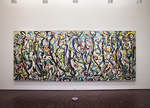New bill might cause University of Iowa’s Jackson Pollock painting to be sold

Courtesy Photo: The Daily Iowan
Jackson Pollock’s “Mural”
February 17, 2011
Deaccession: The way a piece of art is usually removed from a museum’s collection.
If House Study Bill 84 passes, a painting at the University of Iowa may be removed from its collection in a way that hasn’t been done before in Iowa.
HSB 84, which was backed Wednesday morning by the House Appropriations Committee, would require the Iowa Board of Regents to sell a Jackson Pollock painting in order to use the proceeds for scholarship assistance.
“Usage of the moneys in the trust fund is limited to providing scholarship assistance to undergraduate students at the university who are residents of this state and majoring in art. If sufficient funds are available, scholarship assistance is also required to be provided for such undergraduate students with liberal arts majors other than art,” according to the bill.
The painting was appraised at $100 million in 2007, then at $140 million in 2008.
It was donated to the University of Iowa in 1951 by Peggy Guggenheim, who was the leading dealer of modern art in New York at the time.
“[She] recognized the significance of the University of Iowa studio art program, when she gave ‘Mural’ to the university,” according to the University of Iowa Museum of Art website.
The painting, which is simply called “Mural,” was finished in 1943, and was described by Pollock as, “a stampede … [of] every animal in the American west, cows and horses and antelopes and buffaloes. Everything is charging across that goddamn surface.”
Lynette Pohlman, director of museums at Iowa State, said removing a piece of art from a collection “isn’t that easy.”
Pohlman said the best practice for a museum is to look at pieces in terms of aesthetic value to a collection, not financial.
She said an example of a collection being deaccessioned at Iowa State was a collection of dolls donated by Henry and Ann Brunnier.
The dolls in the collection spanned 400 years, but Pohlman said, “Over time it became very apparent they it didn’t have an academic value [for Iowa State].”
She said some of the best dolls were kept, and the rest sold.
Usually after a piece has been deaccessioned, the proceeds go back toward the museum and are used to buy new paintings or to restore old ones.
David Miles, president of the Regents, released a statement saying the sale of the painting is a “profoundly bad idea.”
“It has taken decades for the University of Iowa to build an enviable art collection and outstanding art education programs. A forced sale of this painting by the Iowa Legislature would break trust with all who have contributed to the arts at the University of Iowa over the years, would chill any future donations and may well lead to litigation with the family that donated ‘Mural’ to the University of Iowa in the first place,” according to the statement.
“Crippling an outstanding program in order to provide scholarships for that very same program doesn’t make sense and is a trade‐off Iowans should reject.”
Michael Gartner, member of the Regents, released a response statement:
“Providing scholarships to Iowa students is far more important than owning a painting that is not on the campus, has not been for two years and is unlikely to be for at least another three years. All organizations regularly look at their assets and ask if that’s the best use of money. In this case, the proceeds of as much as $150 million could be used for a far better purpose.”
The painting is currently at the Figge Art Museum in Davenport because the museum on campus was severely damaged by floods in 2008.
Pohlman didn’t have an exact number on how many pieces of artwork at Iowa State were donated, but said it is a great bulk of them.
All but three displays were donated in the Christian-Petersen Art Museum in Morrill Hall.
The collection [corrected from: painting] is insured for $500 million at a current annual cost of $181,476.80, according to a report on questions of the painting done by the Regents in 2008.
The same report said that nothing has been deaccessioned by the University of Iowa within the past 10 years.
Deaccession of Museum of Art collection items require the recommendation of the director of the Museum of Art, in consultation with the curatorial staff and the Museum Advisory Committee, according to the report. If deaccession is recommended, it must be approved by the executive vice president and provost.
“Once deaccession is approved, the item may then be sold or disposed of in a manner consistent with university and Regents’ policies and governing law,” according to the report.
“Accreditation would be in serious jeopardy and most probably would be revoked if the University of Iowa sold a work of art and used the proceeds other than to acquire additional art work. Loss of accreditation would compromise our ability to borrow art from other museums for display at University of Iowa, would reduce [Museum of Art]’s ability to acquire grants to fund exhibitions and programs, and would reduce the likelihood that [the Museum of Arts] would receive donations of additional artwork in the future.”
Since it has passed through the appropriations committee, the bill will have to pass through the House and Senate before any actions can be taken.






